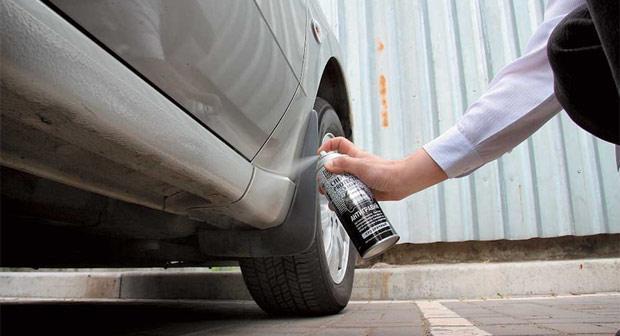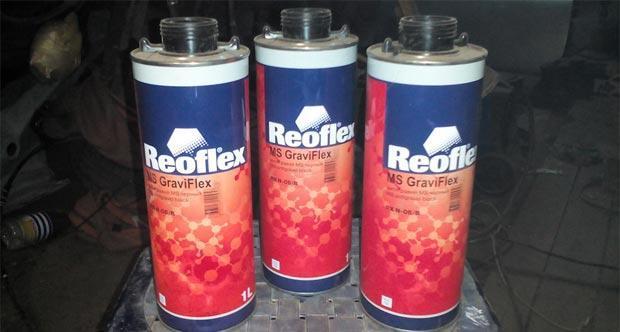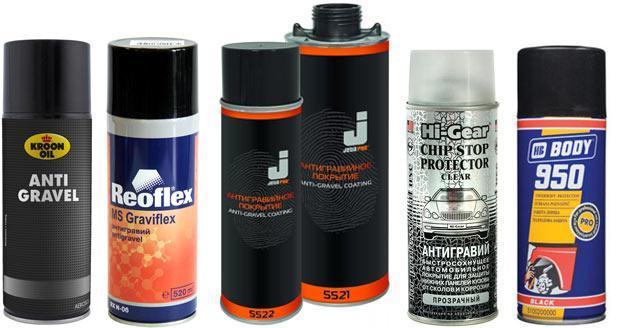
Anti-gravity in cans. Which is better?
How to use anti-gravel in spray cans?
The spray cans of the compositions of all manufacturers are equipped with a spray head, which ensures the uniformity of the applied coating. It is a plastic compound that retains its flexibility under any dynamic loads. Therefore, small pebbles do not stick, but bounce off the original surface without damaging it. Anti-gravel components retain their stability with any type of paintwork.
Tests show that most types of anti-gravel compounds are more resistant to stone chips, but not to bitumen, so if you drive on roads that include bituminous coatings, you will need to periodically clean the bottom of the car, down to the last particle. For it is in that place that the peeling of paint will begin.


The anti-gravity application process consists of the following operations:
- Heating the can in a container with warm water to a temperature of 30 ... 350C: This will ensure an even coating application.
- Preparing the surface of the body, since when anti-gravel is applied to rusty metal, the composition will swell and lag behind over time. Sandblasting is probably the most efficient preparation method.
- Uniform spraying of the composition on the surface, including also the bottom of the doors and bumpers. Coating coverage is usually specified in the instructions, and spray pressure is determined by the design of the spray head. Unprocessed parts of the car are pre-coated with construction tape.
- Drying at room temperature (using a hair dryer to speed up the process is not recommended, since such thermal exposure can lead to the formation of hidden centers of corrosion).
- Secondary treatment of car areas vulnerable to gravel chips and pebbles.


Removal of compounds is carried out using aromatic solvents. It is also a good idea to protect the sills and the edges of the wheel arches, which is carried out in the same sequence.
The main disadvantage of all brands of anti-gravel compositions (however, as well as other bottom coatings), is their inability to repel gravel particles from the surface if it has high humidity. Therefore, after cleaning and rinsing, it is recommended to inspect all seams and remove drops of water from there.
It should be noted that all brands of anti-gravity have a rather short shelf life (about 6 months). Toward the end of the warranty period, the coating components tend to settle randomly at the bottom of the can, and no amount of shaking will restore the uniformity of the composition. Hence the conclusion: you should not purchase a large amount of anti-gravity for future use.


Price
All trademarks approximately equally describe the structure and purpose of the components that make up the anti-gravel aerosols. The basis is usually made up of synthetic resins and rubbers, which have thixotropy - the absence of drops after processing. Also mandatory tasks are good adhesion and the possibility of subsequent painting with any paint and varnish compositions. The price of the issue is determined by the complexity of the technological process of obtaining components by the manufacturer (which is a priori unknown to the user), production volumes and additional amenities provided.
But the latter is very important: for example, Anti-Gravel Coating from the FINIXA brand is characterized by good noise-absorbing characteristics. The HiGear brand positions its line of anti-gravel compounds PRO Line Professional as an effective remedy for sticking not only screenings and sand, but also frozen pieces of snow. The advantage of antigravel KR-970 and KR-971 from the Kerry trademark is the possibility of multiple processing, followed by surface painting (unlike HiGear spray, Kerry compositions are not colorless, and therefore after processing the surface is subject to mandatory painting).


A feature of the anti-gravel offered by the domestic Reoflex trademark is the need for preliminary heat treatment of the surface before application (some users in their reviews indicate heating temperatures up to 40 ... 600WITH). Considering that this manufacturer also produces automotive primers, the compatibility of the compositions should be good.
Body 950 anti-gravel, as well as NovolGravit 600 and Runway compositions are also domestic auto chemical products intended for surface protection of car bottoms. At the same time, NovolGravit 600 contains epoxy compositions that increase the surface strength of the anti-gravity layer.


The price of the compositions considered (for a can with a capacity of 450 ... 600 ml, depending on the manufacturer) is approximately as follows:
- Anti-Gravel Coating (from FINIXA) - from 680 rubles;
- PRO Line Professional (from HiGear) - from 430 rubles;
- Runway (from Chemicals) - from 240 rubles;
- KR-970 / KR-971 (from Kerry) - 220… 240 rubles;
- Reoflex - from 360 rubles;
- NovolGravit 600 - from 420 rubles.


Watch this video on YouTube
